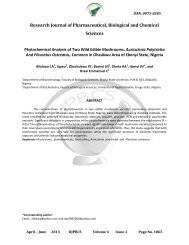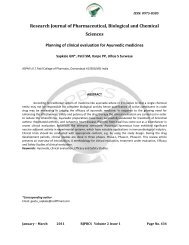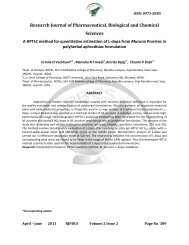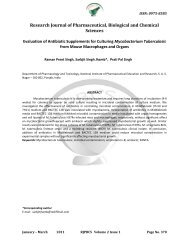antimicrobial activity of ethanol extract of leaf and flower of ...
antimicrobial activity of ethanol extract of leaf and flower of ...
antimicrobial activity of ethanol extract of leaf and flower of ...
You also want an ePaper? Increase the reach of your titles
YUMPU automatically turns print PDFs into web optimized ePapers that Google loves.
ISSN: 0975-8585<br />
Research Journal <strong>of</strong> Pharmaceutical, Biological <strong>and</strong> Chemical<br />
Sciences<br />
Antimicrobial <strong>activity</strong> <strong>of</strong> <strong>ethanol</strong> <strong>extract</strong> <strong>of</strong> <strong>leaf</strong> <strong>and</strong> <strong>flower</strong> <strong>of</strong> Spathodea<br />
campanulata P. Beauv<br />
Rajesh Kowti 1 , Harsha. R 2 , Mohammed Gulzar Ahmed 1* , Hareesh AR 1 ,<br />
Thammanna Gowda SS 2 , Dinesha R 2 , Satish Kumar BP 1 , Irfan Ali M 1<br />
1 -Sri Adichunchanagiri College <strong>of</strong> Pharmacy, B.G. Nagara- 571448, Karnataka, India.<br />
2 -Adichunchanagiri Biotechnology <strong>and</strong> Cancer research Institute, B.G. Nagara- 571448 Karnataka, India.<br />
ABSTRACT<br />
The <strong>ethanol</strong> <strong>extract</strong> <strong>of</strong> <strong>leaf</strong> <strong>and</strong> <strong>flower</strong> <strong>of</strong> Spathodea campanulata was investigated for <strong>antimicrobial</strong><br />
<strong>activity</strong> at 10 mg/ml concentrations by using Kirby-Bauer disc diffusion method against gram positive <strong>and</strong> gram<br />
negative organisms like Escherichia coli, Klebsiella pneumonia, Proteus vulgaris, Pseudomonas sps, Salmonella<br />
typhimurium, Bacillus subtilis, Staphylococcus aureus, Vibrio cholera. After incubation for 24 hrs, the zone <strong>of</strong><br />
inhibition was compared with st<strong>and</strong>ard antibiotics genatmycin <strong>and</strong> streptomycin (10 µg/ disc). From the dose<br />
dependent study it was observed that the <strong>ethanol</strong> <strong>flower</strong> <strong>extract</strong> was more potentent than <strong>leaf</strong> <strong>extract</strong>. Flavonoids<br />
<strong>and</strong> tannins present in the both <strong>ethanol</strong> <strong>extract</strong> may be responsible for the <strong>antimicrobial</strong> <strong>activity</strong>.<br />
Keywords: Spathodea Campanulata, <strong>antimicrobial</strong> <strong>activity</strong>, disc diffusion method, minimum inhibitory<br />
concentration (MIC)<br />
*Corresponding author<br />
E-mail: mohammedgulzar@rediffmail.com<br />
July – September 2010 RJPBCS Volume 1 Issue 3 Page No. 691
INTRODUCTION<br />
ISSN: 0975-8585<br />
Diseases caused by bacteria are widespread worldwide. The treatment <strong>of</strong> these<br />
infections is mainly based on the use <strong>of</strong> antibiotics. In recent years, a number <strong>of</strong> antibiotics<br />
have lost their effectiveness due to the development <strong>of</strong> resistant strains, mostly through the<br />
expression <strong>of</strong> resistance genes [1]. In addition to this problem, antibiotics are sometimes<br />
associated with adverse effects including hypersensitivity, immune-suppression <strong>and</strong> allergic<br />
reactions [2]. Therefore, there is a need to develop alternative antibacterial drugs for the<br />
treatment <strong>of</strong> infectious diseases from various sources such as medicinal plants.<br />
Undoubtedly, medicinal plants are the prime source <strong>of</strong> drugs in both developing <strong>and</strong><br />
developed nations, as drugs or herbal <strong>extract</strong>s for various chemotherapeutic purposes. There<br />
are about 2000+ plant species known to possess medicinal value in the traditional Asian system<br />
<strong>of</strong> medicine[3].The use <strong>of</strong> plant derived natural compounds used as alternative sources <strong>of</strong><br />
medicine continues to play major roles in the general wellness <strong>of</strong> people all over the world. The<br />
curative properties <strong>of</strong> medicinal plants are due to the presence <strong>of</strong> various complex chemical<br />
substances <strong>of</strong> different composition which occur as secondary metabolites [4,5]. They are<br />
grouped as alkaloids, glycosides, corticosteroids, coumarin, flavonoids, <strong>and</strong> essential oils. Over<br />
50% <strong>of</strong> all modern clinical drugs are <strong>of</strong> natural origin [6] <strong>and</strong> play an important role in<br />
development <strong>of</strong> drugs [7,8]. Many herbs have been used for treating disease caused by<br />
microorganisms such as cholera, diarrhea, dysentery, Typhoid <strong>and</strong> bacterial enteritis [9].<br />
Moreover, Huge economy is invested in the imports <strong>of</strong> drugs especially antibiotics from<br />
different parts <strong>of</strong> the world. Therefore, antibacterial <strong>activity</strong> <strong>of</strong> local medicinal plants should be<br />
studied to provide alternative antibacterial regimens. In the continuation <strong>of</strong> this strategy <strong>of</strong> new<br />
drug discovery we have studied only the aerial parts <strong>of</strong> the plant S. campanulata for their<br />
antibacterial, cytotoxic <strong>and</strong> antioxidant properties.<br />
Spathodea campanulata P. Beauv is a <strong>flower</strong>ing plant belonging to the Bignoniaceae<br />
family. It is commonly known as the Fountain Tree, African tulip tree, Flame-<strong>of</strong>-the-forest,<br />
Rudra Palash, Pichkari or N<strong>and</strong>i Flam [10]. It is a tree that grows between 7–25 m (23–82 ft) tall<br />
<strong>and</strong> is native to tropical Africa. Several phytochemical studies were performed with different<br />
parts <strong>of</strong> S. campanulata, including stem barks, <strong>flower</strong>s, leaves, <strong>and</strong> fruits. Spathodic acid,<br />
steroids, saponins, ursolic acid, tomentosolic acid <strong>and</strong> pectic substances have ever been<br />
isolated from the stem bark [11-14]. Flowers <strong>and</strong> stem bark <strong>extract</strong>s have shown molluscicidal<br />
<strong>activity</strong>. These are also employed in diuretic <strong>and</strong> anti-inflammatory treatments. Banerjee <strong>and</strong><br />
DE [15] showed the presence <strong>of</strong> anthocyanins in <strong>flower</strong>s <strong>of</strong> S. campanulata. The stem bark<br />
preparations are used to treat fungus skin diseases, herpes, stomach aches <strong>and</strong> diarrhea [16].<br />
Hypoglycemic, anti-HIV <strong>and</strong> antimalarial activities were also observed in stem bark <strong>extract</strong>s<br />
[17,18]. The leaves are used against kidney diseases, urethral inflammations <strong>and</strong> as an antidote<br />
against animal poisons. In vitro antimalarial <strong>activity</strong> against Plasmodium falciparum <strong>and</strong><br />
antibacterial <strong>activity</strong> <strong>of</strong> bovine mastitis causing S.aureus were evaluated using <strong>leaf</strong> <strong>extract</strong>s <strong>of</strong><br />
S.campanulata [19]. The leaves have been found to contain spathodol, caffeic acid, other<br />
phenolic acids <strong>and</strong> flavonoids [20-23]. In vitro antibacterial <strong>activity</strong> <strong>of</strong> <strong>leaf</strong> <strong>extract</strong>s <strong>of</strong> this plant<br />
July – September 2010 RJPBCS Volume 1 Issue 3 Page No. 692
ISSN: 0975-8585<br />
against st<strong>and</strong>ard strains was evaluated [24]. The phenolic derivatives produced in S.<br />
campanulata roots fungitoxic properties that in vitro [25].<br />
Plant collection & <strong>extract</strong>ion<br />
MATERIALS AND METHODS<br />
Fresh plant leaves <strong>and</strong> <strong>flower</strong>s were collected from B.G. Nagar, M<strong>and</strong>ya (District),<br />
Karnataka, India.. Fresh plant material were washed with tap water, air dried, homogenized to a<br />
fine powder <strong>and</strong> stored in air-tight containers. Same procedure was followed for both <strong>leaf</strong> <strong>and</strong><br />
<strong>flower</strong> <strong>extract</strong>ion. For Ethanol <strong>extract</strong>ion, 100 g <strong>of</strong> air dried powder was <strong>extract</strong>ed with <strong>ethanol</strong><br />
(40-60 o C) in a Soxhlet <strong>extract</strong>or for 18-20 hr <strong>and</strong> solution was evaporated to dryness under<br />
reduced pressure <strong>and</strong> controlled temperature by using roto evaporator. The <strong>extract</strong> was stored<br />
in a refrigerator at 4 °C in air-tight bottles until further use. 10 mg/ml concentration <strong>of</strong> both <strong>leaf</strong><br />
<strong>and</strong> <strong>flower</strong> was prepared in <strong>ethanol</strong> <strong>and</strong> used.<br />
Phytochemical screening [26]<br />
Phytochemical studies <strong>of</strong> <strong>ethanol</strong> <strong>extract</strong>s <strong>of</strong> S. campanulata <strong>flower</strong>s & leaves using<br />
st<strong>and</strong>ard procedures to identify the phytoconstituents (Table-3).<br />
Bacterial culture<br />
Authentic Clinical isolated pure culture <strong>of</strong> human pathogenic bacteria, Escherichia coli,<br />
Klebsiella pneumonia, Proteus vulgaris, Pseudomonas sps, Salmonella typhimurium, Bacillus<br />
subtilis, Staphylococcus aureus, Vibrio cholera were obtained from Microbiology Department,<br />
Adichunchanagiri Institute <strong>of</strong> Medical Science (AIMS), B.G. Nagar, Karnataka, India. All the<br />
strains were confirmed by cultural <strong>and</strong> biochemical characteristics <strong>and</strong> maintained in slants for<br />
further use.<br />
Evaluation <strong>of</strong> Antimicrobial Activity<br />
Antimicrobial <strong>activity</strong> <strong>of</strong> each plant <strong>extract</strong> <strong>and</strong> was determined using a modified Kirby-<br />
Bauer [27,28]. disc diffusion method. Briefly, 100 µl <strong>of</strong> the test bacteria/fungi were grown in 10<br />
ml <strong>of</strong> fresh media until they reached a count <strong>of</strong> approximately 10 8 cells/ml for bacteria, 100 µl<br />
<strong>of</strong> microbial suspension was spread onto the Nutrient agar plates.<br />
The <strong>extract</strong>s were tested using 5 mm sterilized filter paper discs. Discs were<br />
impregnated with 25 µl (10mg/mL concentration) <strong>of</strong> the test samples (<strong>ethanol</strong> <strong>leaf</strong> <strong>and</strong> <strong>flower</strong><br />
<strong>extract</strong>), allowed to dry <strong>and</strong> placed onto inoculated plates (30 min incubation). The plates were<br />
allowed to st<strong>and</strong> at 4 0 C for 2 hours before incubation with the test microbial agents. Plates<br />
inoculated with E. coli, K. pneumonia, P. vulgaris, Pseudomonas sps, S. typhimurium, B. subtilis,<br />
S. aureus <strong>and</strong> V. cholera were incubated at 37 0 C for 24 hours, than the diameters <strong>of</strong> the<br />
inhibition zones were measured in millimetres. Each <strong>antimicrobial</strong> assay was performed in<br />
July – September 2010 RJPBCS Volume 1 Issue 3 Page No. 693
ISSN: 0975-8585<br />
triplicate & mean values were reported. St<strong>and</strong>ard antibiotics, gentamycin (10 µg/ disc),<br />
streptomycin (10 µg/disc) served as positive controls for <strong>antimicrobial</strong> <strong>activity</strong>. Filter discs<br />
impregnated with 10 µl <strong>of</strong> distilled water were used as a negative control. Solvent control disc<br />
(<strong>ethanol</strong>) was also placed with the test, positive <strong>and</strong> negative control.<br />
Dose dependent antibacterial <strong>activity</strong><br />
Both the <strong>leaf</strong> <strong>and</strong> <strong>flower</strong> <strong>ethanol</strong> <strong>extract</strong> was checked for the dose dependent<br />
antibacterial <strong>activity</strong>. Different concentration <strong>of</strong> <strong>extract</strong> (100, 200, 400, 600, 800 1000 µg/disc)<br />
was impregnated on to the disc <strong>and</strong> the same procedure was followed as mentioned before.<br />
Each assay was performed in at triplicate <strong>and</strong> mean <strong>of</strong> all the three experiment were taken.<br />
Minimum inhibitory concentration<br />
The MIC was done by the method described by Ver-poorte [29]. The <strong>extract</strong>s were<br />
incorporated into Mueller-Hinton broth at concentration ranging from 0.01-10mg/ml. A control<br />
tube containing the growth medium <strong>and</strong> the bacteria was set-up. The mixtures were incubated<br />
at appropriate temperature <strong>of</strong> 37°C for 24h. The minimum inhibitory concentration (MIC) <strong>of</strong> the<br />
<strong>extract</strong>s was regarded as the lowest concentration <strong>of</strong> the <strong>extract</strong> that did not permit <strong>and</strong><br />
turbidity or growth <strong>of</strong> the test organisms.<br />
RESULTS AND DISCUSSION<br />
The <strong>antimicrobial</strong> <strong>activity</strong> <strong>of</strong> <strong>ethanol</strong> <strong>extract</strong> <strong>of</strong> leaves <strong>and</strong> <strong>flower</strong>s S. campanulata<br />
against human pathogenic bacteria, Escherichia coli, Klebsiella pneumonia, Proteus vulgaris,<br />
Pseudomonas sps, Salmonella typhimurium, Bacillus subtilis, Staphylococcus aureus, Vibrio<br />
cholera were measured by measuring the zone <strong>of</strong> inhibition in disc diffusion method. Test<br />
sample per disc was about 250 µg/disc. The organisms used <strong>and</strong> zone <strong>of</strong> inhibition to the<br />
corresponding <strong>extract</strong>s are shown in Table 1. The Zone <strong>of</strong> inhibition ranged from 6 – 8 mm <strong>and</strong><br />
8.6 – 11.2 mm for <strong>leaf</strong> <strong>and</strong> <strong>flower</strong> <strong>extract</strong> respectively.<br />
Antibacterial <strong>activity</strong> at different doses was done by disc diffusion method.<br />
Concentration was in the range <strong>of</strong> 100 to 1000 µg/disc. Activity was dependent on the dose <strong>of</strong><br />
the test material. As the concentration increased the inhibition zone was also increased.<br />
Against <strong>ethanol</strong> <strong>leaf</strong> <strong>extract</strong>, Proteus vulgaris, Escherichia coli <strong>and</strong> Klebsiella pneumonia showed<br />
a highest inhibition zone <strong>of</strong> 16, 15 <strong>and</strong> 14 respectively where as Staphylococcus aureus showed<br />
a lesser inhibition zone <strong>of</strong> about 10 mm (Figure 1). Ethanol Flower <strong>extract</strong> showed more<br />
potency than the <strong>leaf</strong> <strong>extract</strong>. Against Klebsiella pneumonia, Vibrio cholera, Staphylococcus<br />
aureus <strong>and</strong> Proteus vulgaris it showed 19, 18.5, 18 <strong>and</strong>17mm at 1000 µg/disc. Salmonella<br />
typhimurium showed a lesser inhibition zone <strong>of</strong> 14 mm (Figure 2).<br />
MIC value for both Leaf <strong>and</strong> <strong>flower</strong> <strong>extract</strong> against the bacterial strains were done by<br />
serial dilution method. MIC values for <strong>leaf</strong> <strong>extract</strong> ranged from 221 – 254 µg/mL <strong>and</strong> 156 – 173<br />
µg/mL for <strong>leaf</strong> <strong>and</strong> Flower <strong>ethanol</strong> <strong>extract</strong> respectively. Against <strong>leaf</strong> <strong>extract</strong>, E. coli showed a<br />
July – September 2010 RJPBCS Volume 1 Issue 3 Page No. 694
ISSN: 0975-8585<br />
minimum value <strong>of</strong> 221 µg/mL where as against <strong>flower</strong> <strong>extract</strong>, P. vulgaris showed 156 µg/mL.<br />
Table 2 shows the MIC values <strong>of</strong> both <strong>leaf</strong> <strong>and</strong> <strong>flower</strong> <strong>extract</strong>. Ethanol Flower <strong>extract</strong> seem to<br />
be more potent than the <strong>ethanol</strong> <strong>leaf</strong> <strong>extract</strong>.<br />
Figure 1. Dose dependent antibacterial <strong>activity</strong> <strong>of</strong> Leaf <strong>extract</strong> <strong>of</strong> S.campanulata<br />
Figure 2. Dose dependent antibacterial <strong>activity</strong> <strong>of</strong> <strong>flower</strong> <strong>extract</strong> <strong>of</strong> S.campanulata<br />
July – September 2010 RJPBCS Volume 1 Issue 3 Page No. 695
ISSN: 0975-8585<br />
Table 1. Antibacterial <strong>activity</strong> <strong>of</strong> <strong>ethanol</strong> <strong>extract</strong>s <strong>of</strong> Spathodea campanulata <strong>leaf</strong> <strong>and</strong> <strong>flower</strong><br />
Zone <strong>of</strong> inhibition in (mm) at Zone <strong>of</strong> inhibition in (mm) at 10<br />
250 µg/disc<br />
µg/disc<br />
Spathodea campanulata<br />
St<strong>and</strong>ard antibiotic<br />
Organisms<br />
Ethanolic <strong>extract</strong><br />
Leaf Flower Gentamycin Streptomycin<br />
Escherichia coli 8.0±0.25 9.6±0.6 26±1 17±0.5<br />
Staphylococcus aureus 6.0±0.5 8.8±0.4 23±0.6 19±1<br />
Klebsiella pneumonia 6.5±0.5 10.5±0.5 21±0.5 17±0.5<br />
Proteus vulgaris 7.2±0.3 10.4±0.4 20±1 14±1<br />
Pseudomonas sps 6.2±0.2 8.6±0.5 24±1 16±0.5<br />
Salmonella typhimurium 6.5±0.4 9.2±0.5 24±1 18±0.5<br />
Bacillus subtilis 7.2±0.2 9.6±0.5 30±0.5 17±2<br />
Vibrio cholera 6.8±0.5 11.2±0.4 23±0.6 18±1<br />
The results are mean S.D (n=3).<br />
Table 2. Minimum inhibition concentration <strong>of</strong> <strong>ethanol</strong> <strong>extract</strong>s <strong>of</strong> Spathodea campanulata <strong>leaf</strong> <strong>and</strong> <strong>flower</strong><br />
MIC in µg/ml MIC in µg/ml<br />
Spathodea campanulata<br />
St<strong>and</strong>ard antibiotic<br />
Organisms<br />
Ethenolic <strong>extract</strong><br />
Leaf Flower Gentamycin Streptomycin<br />
Escherichia coli 221±1.25 168±1.5 20±0.2 13.7±0.5<br />
Staphylococcus aureus 236±1.5 162±1.5 20.8±0.5 16.9±0.3<br />
Klebsiella pneumonia 225±1.5 162±0.5 16.8±0.5 13.7±0.1<br />
Proteus vulgaris 238±0.5 161±1 16±0.2 12.3±0.4<br />
Pseudomonas sps 254±0.5 156±0.5 19.2±0.3 12.6±0.2<br />
Salmonella typhimurium 243±1 173±0.5 19.4±0.3 14.4±0.4<br />
Bacillus subtilis 241±1.5 158±1.5 24.1±0.3 17±0.2<br />
Vibrio cholera 246±1 149±1.5 18.3±0.4 13.8±0.3<br />
The results are mean S.D (n=3).<br />
Table 3. Phytochemical screening <strong>of</strong> Spathodea campanulata <strong>leaf</strong> <strong>and</strong> <strong>flower</strong><br />
Phytochemicals Leaf <strong>extract</strong> Flower <strong>extract</strong><br />
Alkaloids +ve +ve<br />
Tannin +ve +ve<br />
Saponin +ve +ve<br />
Steriod +ve +ve<br />
Phlobatannin -ve -ve<br />
Terpenoid +ve +ve<br />
Flavonoid +ve +ve<br />
Phenolics +ve +ve<br />
Proteins -ve -ve<br />
Glycoside +ve +ve<br />
July – September 2010 RJPBCS Volume 1 Issue 3 Page No. 696
ISSN: 0975-8585<br />
Phytochemical analysis (Table 3) <strong>of</strong> <strong>ethanol</strong> <strong>extract</strong>s showed the presence <strong>of</strong> alkaloids,<br />
saponins, steroids, anthraquinone glycosides, flavonoids, triterpenoids <strong>and</strong> tannins.<br />
In our study, a wide range <strong>of</strong> human pathogenic microorganisms were examined, including<br />
Gram-positive <strong>and</strong> Gram-negative bacteria, This may partly indicate that the <strong>leaf</strong> <strong>and</strong> <strong>flower</strong><br />
<strong>extract</strong>s <strong>of</strong> S. campanulata have broad inhibitory activities to pathogenic microorganisms <strong>and</strong><br />
are promising to act as potential antibacterial agents from natural plant sources.<br />
Active compounds present in the crude <strong>ethanol</strong> <strong>extract</strong>s show the antibacterial <strong>activity</strong><br />
with the dose dependant manner. If the active principle is present in high quantities, there<br />
could be other constituents exerting antagonistic effects <strong>of</strong> the bioactive compounds. So this<br />
may be happening with the <strong>ethanol</strong> <strong>flower</strong> <strong>extract</strong> where it shows more potency than the <strong>leaf</strong><br />
<strong>extract</strong>. Polyphenolic, flavonoids <strong>and</strong> tannins present in the <strong>ethanol</strong> <strong>extract</strong> may be responsible<br />
for the antibacterial <strong>activity</strong>. Tannin is known to show the antibacterial <strong>activity</strong> by precipitation<br />
the microbial proteins. Flavonoids are produced by the plants for the defense against the<br />
infection. So, use <strong>of</strong> the crude <strong>ethanol</strong> <strong>extract</strong> <strong>of</strong> this plant as an agent to control microbial<br />
pathogens needs further extensive research for their better economic <strong>and</strong> therapeutic<br />
utilization. The findings from this work may add to the overall value <strong>of</strong> the medicinal potential<br />
<strong>ethanol</strong> <strong>extract</strong> <strong>of</strong> <strong>leaf</strong> <strong>and</strong> <strong>flower</strong> <strong>extract</strong> <strong>of</strong> S. campanulata. Further phytochemical studies are<br />
required to determine the purified fractions/bioactive compounds responsible for the<br />
antibacterial activities <strong>of</strong> these species, which could serve as useful sources for new<br />
<strong>antimicrobial</strong> agents.<br />
From the above studies it can be concluded that the <strong>ethanol</strong> <strong>extract</strong>s <strong>of</strong> both Leaf <strong>and</strong><br />
<strong>flower</strong> <strong>extract</strong> <strong>of</strong> S. campanulata exhibit significant antibacterial <strong>activity</strong> against pathogenic<br />
bacteria. The inhibited <strong>extract</strong>s showed high polyphenols, tannins <strong>and</strong> flavonoids content.<br />
Therefore this S. campanulata <strong>leaf</strong> <strong>and</strong> <strong>flower</strong> may be act as another source <strong>of</strong> natural<br />
antibiotic. This study reaffirms the ethanomedicinal property <strong>of</strong> S. campanulata.<br />
ACKNOWLEDGEMENT<br />
We are thankful to Principal, SAC college <strong>of</strong> Pharmacy for providing the facilities for<br />
research work. Authors are also thankful to Adichunchanagiri Biotechnology <strong>and</strong> Cancer<br />
Research Institute, B.G. Nagar for their kind support. We also thankful to Department <strong>of</strong><br />
Microbiology, AIMS, B.G. Nagar, for providing the bacterial strains.<br />
REFERENCES<br />
[1] Davis J. Science 1994; 264: 375–382.<br />
[2] Ahmad I, Mehmood Z, Mohammad F. J Ethnopharmacol 1998;62:183–193.<br />
[3] Agnese AM, Perez C, Carbrera. Phtyomed 2001; 7(5):389-394.<br />
[4] Karthikeyan A, Shanthi V, Nagasathaya A. Int J Green Pharm 2009;3:78-80.<br />
July – September 2010 RJPBCS Volume 1 Issue 3 Page No. 697
ISSN: 0975-8585<br />
[5] Metta Ongsakul, Arunsri Jindarat, Chanapong Rojanaworarit. J Health Res 2009;<br />
23(3):153-156.<br />
[6] Stuffness M. <strong>and</strong> Douros J. J Nat Prod 1982;45: 1-14.<br />
[7] Baker JT, Borris RP, Carte B, Cordell GA, Soejarto DD, Cragg GM, Gupta MP, Iwu<br />
MM, Madulid DR, Tyler VE. J Nat Prod 1995; 58: 1325-1357.<br />
[8] Cordell G. Phytohemistry 1995;40:1585-1612.<br />
[9] Cowan MM. Clin Microbiol Rev 1999;12: 564-582.<br />
[10] Baaza Mendonça, Luciana & Dos Anjos, Luiz. Revista Brasileira De Zoologia 2005;<br />
22(1): 51–59.<br />
[11] Ngouela S, Tsamo E, Sondenga B. L. Planta Medica Stuttgart 1988; 54: 476.<br />
[12] Ngouela S, Nyasse B, Tsamo E, Sondengam BL, Connolly J. D. Phytochemistry<br />
1990; 29 :3959-3961.<br />
[13] Amusan O.O.G, Msonthi J. D, Makhubu LP. Fitoterapia 1995;66:113-116.<br />
[14] Amusan OOG, Adesogan EK, Makinde J. Phytotherapy Research 1996; 10: 692-<br />
693.<br />
[15] Banerjee A, De B. J Med Arom Plant Sci 2001; 23: 600-604.<br />
[16] Mendes NM, Souza CP, Araúj N, Pereira JP, Katz N. Rio de Janeiro 1986;81: 87-<br />
91.<br />
[17] Makinde JM, Amusan OOG, Adesogan EK. Planta Medica 1988;54: 122-125.<br />
[18] Niyonzima G, Laekeman G, Witvrouw M, Van Poel B, Pieters L, Paper D, Clercq E,<br />
Franz G, Vlietinck A. J Phytomedicine 1999; 6: 45-49.<br />
[19] Dhanabalan R. Doss A, Jagadeeswari M, Karthic R, Palaniswamy M, Angayarkanni<br />
J Ethnobotanical Leaflets 2008; 12: 811-19.<br />
[20] Ngouela S, Tsamo E, Sondengam BL, Connolly JD. J Nat Prod 1991; 54:873-876.<br />
[21] Subramanian SS, Sulochana N, Nagarajan S. Curr Sci 1973;42: 403.<br />
[22] El-Hela AA. J Pharm Sci 2001; 27: 152-162.<br />
[23] El-Hela A.A. J Pharm Sci 2001; 27: 115-120.<br />
[24] Parekh J, Ch<strong>and</strong>a S. Afr J Biol Res 2007; 10: 175-181.<br />
[25] Adriana P, Jur<strong>and</strong>ir PP, Dalva TF, Noemia KI, Raimundo BF. Ciências Agrárias<br />
2007; 28: 251-256,<br />
[26] Kokate CK, Purohit AP, Gokhale SB, Pharmacognosy, 7 th edi,1997, pp 105-144.<br />
[27] Bauer AW, Kirby WMM, Sherries M. Am J Clin Pathol 1966; 45: 493-496.<br />
[28] Rios JL, Recio MC, Villar A. J Ethnopharmacol 1988; 23: 127- 149.<br />
[29] Verporte R, Ijin A, Tsoui A, V<strong>and</strong>ourne H <strong>and</strong> Baerheim M. J Ethanopharmacol<br />
1982; 5: 221-226.<br />
July – September 2010 RJPBCS Volume 1 Issue 3 Page No. 698













